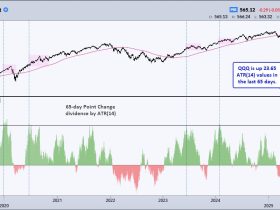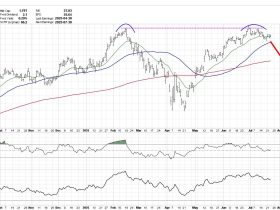Uncertain about where the stock market’s headed? You should be, after a tumultuous 2022. Read on to hear what three experts think the 2023 investment landscape will look like. More importantly, get ready to take advantage of new trading and investing opportunities.
Forecasting the stock market is like predicting the weather. You never know what’s going to happen from one moment to the next. The stock market can be a tricky beast, but 2023 could be a big year for investors. Whether you’re a short-term trader or long-term investor, insights from three technical analysts—Mish Schneider, Tom Bowley, and Greg Schnell, CMT—are sure to help you focus on specific areas and get a better idea of what trends to watch out for.
In a recent StockCharts TV special, “Charting Forward: Q1 Market Outlook,” our chief market strategist and host of The Final Bar, David Keller, CMT, picked the brains of the three panelists in a round table discussion to get their thoughts on the market, which areas are likely to outperform, and which areas are likely to underperform. Here’s a glimpse at the different points of view.
CHARTWATCHERS KEY POINTS
Commodities could shine in 2023, especially precious metalsEnergy stocks are forming a base and oil prices could see a bullish rallyEquities are looking bullish and the biggest challenge in 2023 will be growth vs. value stocks
The Commodity Cycle
Mish Schneider, director of trading education at MarketGauge.com, is bullish on commodities. Here’s her outlook.
If you look back to the late 1970s, after a recessionary period, there was a bear market. The stock market then hit a trading range. During this time, commodities started to shine. A similar scenario is likely to play out in 2023.
The S&P 500 index ($SPX) has been between 3200 and 4200 and we’re close to testing the upper region of the range. Given that inflation is a global phenomenon, equities could remain stagnant for a while, which is why commodities are likely to be bullish in 2023. It wouldn’t be surprising to see the U.S. dollar fall further and equities continue to remain flat, with some periods of excitement. But if you want to catch the big trends, don’t lose track of energy, food, and metals.
The 80-month moving average (MA) represents a breakdown of the business cycle, and a lot of growth stocks have broken below their 80-month MA. But if you pull up a chart of commodity exchange-traded funds (ETFs) such as Invesco DB Commodity Index Tracking Fund (DBC), you’ll see the opposite taking place (see chart 1). These ETFs are trading above their 80-month MA.
CHART 1: A POTENTIAL COMMODITY CYCLE COULD BE IN THE WORKS. The Invesco DB Commodity Index fund (DBC) is trading well above its 80-month moving average.Chart source: StockChartsACP. For Illustrative purposes only.One important point about commodities: When they’re beaten down, it could mean buying opportunities. When they look great, you may want to sell them. Commodities have been trading sideways for years. 2023 may be their year.
If gold futures hold $1,900 per ounce, there’s no reason the shiny metal can’t go as high as $3,000 to $3,500 an ounce. Commodities are emotional, countries need them, and so do governments. Now that demand for commodities is growing, it’s possible that oil could lead the charge, and may be the key to ignition. ~Mish Schneider
Bullish on Energy
Greg Schnell, CMT, MFTA, chief technical analyst at Osprey Strategic, is stoked about energy. Here’s why.
With the U.S. dollar breaking down, it could benefit other asset classes. The $SPX is likely to break to the upside, reaching the 4,500 level. And expect copper to be the theme going forward, especially with wind and solar technologies. Note that Copper is considered an economic bellwether and is seeing some upside potential.
When the demand for energy increases, there’s a chance that energy stocks will pop. Pull up a chart of the Energy Select Sector SPDR ETF (XLE) and you’ll see that it could be indicating the start of the next bull leg. If that were to play out, energy won’t get left behind.
A lower U.S. dollar bodes well for a rise in commodities. If you look at a 30-year monthly chart of the CRB index ($CRB) with the percentage price oscillator (PPO), such as in chart 2, you’ll see that the PPO is the highest it’s been. So keep an eye on this indicator and, if PPO turns up and moves higher in the next low, you may want to add commodities-related stocks or ETFs to your portfolio.
CHART 2: COMMODITIES LOOKING STRONG. Look for the PPO to go closer to zero and then turn higher. That could be an indication to invest in commodity stocks or ETFs.Chart source: StockChartsACP. For illustrative purposes only.
We’ve seen energy stock prices go up, but crude oil prices have been at a base of around $75 per barrel, which could be the floor. If you wanted to invest in oil, you’d want to buy it at a low, and there’s a chance crude oil prices could rise from the $75 level. Going back to the 40-period MA, it looks like crude oil prices are pretty close to hitting that MA.
We’re going on a run for the roses here. When crude oil crosses the center line (40-period MA) on the ice rink, oil will go deep into the zone. ~Greg Schnell
Value vs. Growth Stocks
Tom Bowley, chief market strategist of EarningsBeats.com, is pretty bullish going into 2023. Here’s why he thinks $SPX has hit a bottom.
The stock market had gone up so much in 2020 and 2021 that a reversion to the mean was due, which happened in 2022. There’s a lot of accumulation going on, and the biggest challenge in 2023 will be deciding between growth and value stocks. A lot will depend on what the Fed does and where interest rates go from here, but it’s likely $SPX will move higher, maybe to 4,700 or even an all-time high later in the year.
In 2022 there was a shift in the markets in Q4. The Dow Jones Industrial Average ($INDU) was up 17%, while the Invesco QQQ Trust (QQQ) was relatively flat. Large $SPX market cap-weighted stocks struggled, yet the index gained in Q4. This supports the idea that money is rotating into the markets, as well as the possibility of a bull market in equities.
Value stocks are probably going to outperform growth stocks in 2023, although at some point growth stocks will come back. Pull up a chart of IWF:IWD and you’ll see a reversion to the mean (see chart 3). In a low-interest rate environment, growth stocks tend to perform better. You don’t want to be overweight in growth stocks until interest rates start coming down. That’s when investing in S&P 500 companies will make more sense.
Using my fundamental background, if rates start to come down, growth stocks will benefit. Then, from a technical perspective, I wait to see a turn in the charts. Most bull markets will lift all boats. ~Tom Bowley
CHART 3: GROWTH VS. VALUE. Here you see the ratio of growth stocks to value stocks. Growth stocks have been underperforming value stocks in Q4 2022. Will the trend continue into 2023? It could, at least in the early part of 2023. It would also be interesting to see the reaction at the 50-day moving average (blue line).Chart source: StockChartsACP. For illustrative purposes only.
Long-Term Trends and Sentiment Shifts
It goes without saying that analyzing prevailing and long-term trends is the key to getting an idea of what the stock market might look like in the future. But, like the weather, nothing is certain in the markets. So be prepared to consider investing in markets that may not have been on your radar in the past. Keep a close eye on shifting investor sentiment; it can go a long way in determining which assets should be in your portfolio and which ones should leave. Stay tuned for next quarter’s market outlook.
Want to hear more from the three talented technical analysts? Check out the entire conversation in the video below.
Jayanthi Gopalakrishnan
Director, Site Content
StockCharts.com
Disclaimer: This blog is for educational purposes only and should not be construed as financial advice. The ideas and strategies should never be used without first assessing your own personal and financial situation, or without consulting a financial professional.









